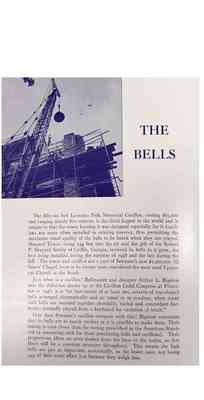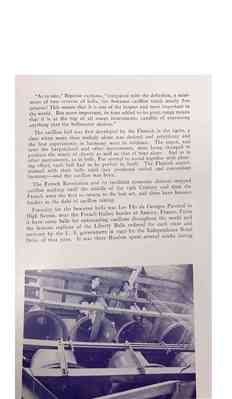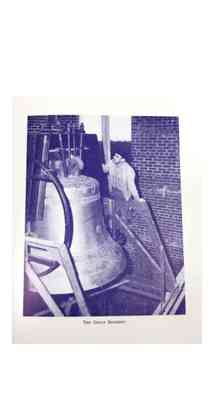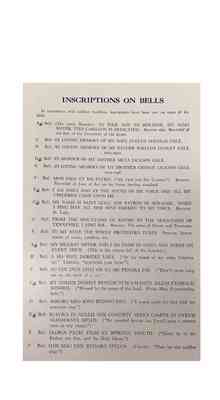Pages
6
The fifty-six bell Leonidas Polk Memorial Carillon, costin $65,000 and ranging nearly five octaves, is the largest in the world and is unique in that the tower housing it was designed especially for it (carillons are more often installed in existing towers), thus permitting the maximum tonal quality of the bells to be heard when they are played. Shapard Tower, rising 134 feet into the air and the gift of the Robert P. Shapard family of Griffin, Georgia, received its bells as it grew, the first being installed during the summer of 1958 and the last during the fall. The tower and carillon are a part of Sewanee's new $1,200,000 All Saints' Chapel, even in its former state considered the most use Episcopal Church in the South.
Just what is a carillon? Bellmaster and designer Arthur L. Bigelow uses the definition drawn up at the Carillon Guild Congress at Princeton in 1946: it is "an instrument of at least two octaves of cup-shaped bells arranged chromatically and so tuned as to produce, when many such bells are sounded together chordally, varied and concordant harmony; normally played from a keyboard for variation of touch."
How does Sewanee's carillon compare with this? Bigelow comments that its bells are as perfect as it is possible to make them. Their tuning is even closer than the tuning prescribed in the American Standard (a measuring stick for those purchasing bells and carillons). Their proportions allow an even timbre from the bass to the treble, so that there will be a constant intensity throughout. This means the high bells are just as important, acoustically, as the lower ones, not losing any of their tonal effect just because they weigh less.
7
"As to size," Bigelow explains, "compared with the definition, a mini0 mum of two octaves of bells, the Sewanee carillon totals nearly five octaves! This means that it is one of the largest and most important in the world. But more important, its tone added to its great range means that it is at the top of all tower instruments, capable of expressing anything that the bellmaster desires."
The carillon bell was first developed by the Flemish in the 1400s, a time when more than melody alone was desired and polyphony and the first experiments in harmony were in evidence. The organ, and later the harpsichord and other instruments, were being changed to produce the music of chords as well as that of tune alone. And as in other instruments, so in bells. For several to sound together with pleasing effect, each bell had to be perfect in itself. The Flemish experimented with their bells until they produced varied and concordant harmony- and the carillon was born.
The French Revloution and its resultant economic distress stopped carillon making until the middle of the 19th Century and then the French were the first to return to the lost art, and since have become leaders in the field of carillon tuning.
Foundry for the Sewanee bells was Les Fils de Georges Paccard in High Savorie, near the French-Italian border at Annecy, France. From it have come bells for outstanding carillons throughout the world and the famous replicas of the Liberty Bells ordered for each state and territory by the U.S. government in 1950 for the Independence Bond Drive of that year. It was there Bigelow spent several weeks during
8
the summer of 1957 testing the bells with tuning forks. The foundry was too small to set up the carillon for playing, so the bells were moved by raft to the Isle of Swans on a nearby lake. Here, with the Alps in the background, the lake dotted with small boats, and with people gathered on the mainland coast, Bigelow gave "testing" concerts all during August. The largest bell, the bourdon, weighs nearly four tons and the smallest weighs twenty-two pounds. An electric motor eliminates bell-pulling by rope, and the motor swings the bourdon. This massive bell will also strike the hour for Breslin Tower's clock. The fifty-six bells (total weight: twenty-three tons) are made of bronze, the largest ones being seventy-eight percent copper and twenty-two percent tin. To give the small, high bells more "ring" a greater percentage of tin was used. The four-story split belfry begins with the bourdon on the botttom, than the seven other bass bells, then the keyboard, officially termed a clavier, and on top the medium and high bells. The keys resemble broom handles and their two rows correspond to the white and black keys of the piano. At the keyboard the bellmaster is in the midst of his bells, a location of prime importance, according to Bigelow. Connections between keys and appropriate bells must be kept within twelve to fiftteen feet "for the sake of controllability," he exlains. Practicing can be done in private on a special practice keyboard connected to small steel bars, each bar being carefully tuned to its corresponding bell, and set up in Sewanee's Music Studio. Weekly Sunday sftertoon concerts are anticipated on the Polk Carillon. Again to quote Designer Bigelow: "In the quiet of an afternoon set aside, or the stillness of an evening planned for it, the carillon will be heard pealing out a very special form of music proper only to itself, a music inexpressible upon any other instrument. Here the bells will make themselves felt and loved for their sheer beauty in music so appealing, floating down from the belfry, so pure, so strong, so tender, so incomparable. It expreses all moods. It endears itself to all. And it will be a part of Sewanee, a presence, a being."
10
INSCRIPTIONS ON BELLS In accordance with carillon tradition, inscriptions have been cast on some of the bells. A# Bell: (The great Bourdon) TO POLK AND TO SEWANEE, MY ALMA MATER, THIS CARILLON IS DEDICATED. Reverse side: Bas-relief of the Seal of the University of the South. C Bell: IN LOVING MEMORY OF MY WIFE EVELYN DOUGLAS GALE. D Bell: IN LOVING MEMORY OF MY FATHER WILLIAM DUDLEY GALE. 1861-1921 D# Bell: HONOUR OF MY MOTHER META JACKSON GALE. E Bell: IN LOVING MEMORY OF MY BROTHER GEORGE JACKSON GALE. 1902-1946 F Bell: MON DIEU ET MA PATRIE ("My God and My Country"). Reverse: Bas-relief of Joan of Arc on her horse, bearing standard. F# Bell: I AM JESUS AND AT TEH SOUND OF MY VOICE MAY ALL MY CHILDREN COME UNTO ME. G# Bell: MY NAME IS SAINT LUKE, THE PATRON OF SEWANEE. WHEN I SING MAY ALL HER SONS HARKEN TO MY VOICE. Reverse: St. Luke. G Bell: FROM THE MOUNTAINS OF SAVOIE TO THE MOUNTAINS OF TENNESSEE, I SING SOL. Reverse: The arms of Savoie and Tennessee. A Bell: TO MY NOTE THE WHOLE ORCHESTRA TUNES. Reverse: Instruments of music, panflute, etc. A# Bell: MY BIGGEST SISTER AND I GO HAND IN HAND AND AGREE ON EVERY ISSUE. (This is the octave bell of the bourdon.) B Bell: A MA VOIX DERIDEZ VOUS. ("At the sound of my voice, brighten up." Literally, "unwrinkle your brow.") C Bell: AU COU D'UN CHAT ON NE ME PENDRA PAS. ("They'll never hang me on the neck of a cat.") C# Bell: SIT NOMEN DOMINI BENEDICTUM LAUDATE ILLUM CYMBALIS SONORIS. ("Blessed be the name of the Lord. Praise Him, O resounding bells.") D Bell: SONORO MEO SONO RESONO DEO. ("I sound again for God with my sonorous ring.") D# Bell: SUAVIUS IN NULLIS VOX CONCINIT AENEA CAMPIS IN GYRUM GLOMERATA MELOS. ("No rounded bronze has [ever] sung a sweeter tune on any campi.") E Bell: GLORIA PATRI FILIO ET SPIRITUI SANCTO. ("Glory be to the Father, the Son, and the Holy Ghost.") F Bell: DAN MAG DEN BEIAARD SPELEN. (Flemish: "Then let the carillon play.")




